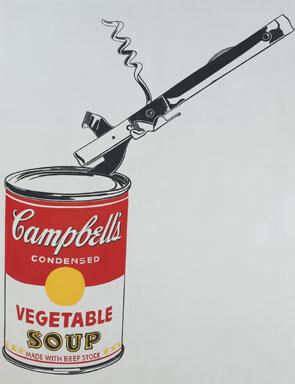Bid Here….
In the 48 years since it was executed Big Campbell’s Soup Can with Can Opener (Vegetable) has only had three private owners. The New York collectors, Burton and Emily Tremaine bought the painting directly from Warhol’s Factory in 1962 and sold it, in the late 1970s to Ted Ashley, the former chairman of Warner Brothers. In 1986, Christie’s sold it to British Art dealer, James Mayer for a paltry $264,000. It was than sold on to its present owner, Cruise line and property Venture Capitalist, Barney Ebsworth. The painting is now being offered at Christie’s New York on 10 November for a price on application estimate of 30-50 million dollars. The proceeds will go to building a church in the Seattle area.
Flash Update
“Andy Warhol’s hand-painted Big Campbell’s Soup Can with Can Opener (Vegetable), 1962 sold to an anonymous bidder for $23,882,500/ £14,807,150/ €17,434,225. At six feet high, the painting is one of the largest examples of Warhol’s most famous images of a Campbell’s Soup Can.
Is this a ridiculous price tag for a transitional work by an artist who died in 1987? If so it is not a one off, there is currently a ‘Bull Market’ eager to purchase important works of post war contemporary artists. Let us not forget Sotheby’s over hyped “Walking Man” sculpture by Giacometti’s which sold for a record $104.3 million last February, to a collector most likely unaware that there were six other casts of the figure produced. If ‘Big Campbell Soup Can actually reaches its reserve. It will join other Warhol’s such as ‘Car Crash Green’ which sold for $71.7 million in 2007 and Tom Ford’s so called, ‘Warhol in A Fright Wig,’ a ghastly late canvas which realized $32.5 million.
Christies describes ‘Big Campbell’s Soup Can’ as, “Warhol’s eponymous static soup can pierced by a can opener against a seamless background. The hand-painted masterpiece is an icon of Pop Art and is one of the largest examples of Warhol’s most famous and beloved image of a Campbell’s Soup Can — a subject matter that helped shape the course of art history in the 1960s.
Art critic,Henry Geldzahler would recall, ‘The Campbell’s Soup Can was the Nude Descending a Staircase of Pop Art. Here was an image that became an overnight rallying point for the sympathetic and the bane of the hostile. Warhol captured the imagination of the media and the public, as had no other artist of his generation. Andy was pop and pop was Andy’ (H. Geldzahler, quoted in V. Bockris, Ibid., 1998, pp. 159-60).
The question remains is this soup can an iconic Warhol painting? Or is it a transitional potboiler that is being over hyped by Christie’s to an over stimulated Warhol market? Auctioneers expect it to fetch the multi-million dollar sum because only 11 large-scale soup-can paintings are in existence; all but three are held by museums and this was the first Warhol to be exhibited in a museum, having graced the walls of the Wadsworth Atheneum Museum of Art in Hartford Connecticut, a bonus which makes this dull work historically interesting. I am sure the Warhol foundation, reeling, from scandal over the Brillo Box fiasco and the status demotion of the ‘ Red Self Portrait’ (See 26 July article) series. Is happy to see Warhol’s work spiral out of control, at least there is no question of provenance with this painting.
My problem with the painting is visual. This is not one of Warhol’s best compositions. The fact remains that it is an awkward and clumsy canvas. The out of proportion can opener juts out of the lid and the can is crammed into the bottom left hand area of the canvas. This is also compounded by the hand painted (this is not one of the later slick silkscreens) surface with all of its imperfections both in texture and perspective. The rendering of the can is quite crude and roughly painted by comparison to the later photographic works. Does this small point of aesthetics matter? We will soon find out.
Other Warhols to be sold in the Christie’s Post-War and Contemporary fall 2010 auctions include: Campbell’s Soup Can (Tomato), 1962 (estimate: $6,000,000-8,000,000), Marilyn, 1962 (estimate: $4,000,000-6,000,000) and Dollar Sign, 1981, (estimate: $2,500,000-3,500,000).

